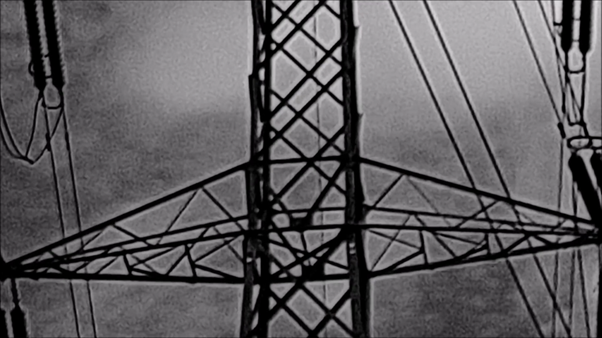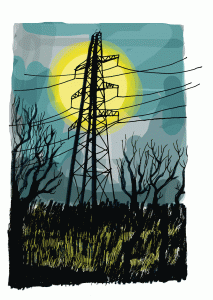 LOCATION: Essex
LOCATION: Essex
WORDS: Gary Budden
PICTURES: Maxim Griffin
The book I chose to take deep into Essex’s marshland (from a choice of many) was The Hamlyn Guide to Birds, revised edition, published 1987. It’s been with me as long as I can remember and there still grains of sand stuck between the plastic sheath and cardboard cover, from a trip distant in both time and geography.
Andy and I look up the record for ‘little egret’, the elegant white heron. Each bird has its own map of Europe shaded in various colours informing of where the birds will be at what time of year.
For the egret’s entry, the UK is a white colourless wasteland.
Yet, flitting over there right now on the marsh, is an egret.
*
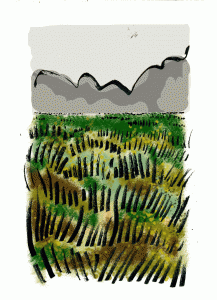 About half a mile walk from Purfleet station to the Rainham Marshes reserve. We pass old railway cottages, new plots of land acquired for development, a closed Italian coffee hut.
About half a mile walk from Purfleet station to the Rainham Marshes reserve. We pass old railway cottages, new plots of land acquired for development, a closed Italian coffee hut.
The Purfleet Magazine (‘Defending the Thames’) is now unloved and broken down, but the river is majestic, rippling and shining in winter light. Here it’s easy to summon the ghosts of an industrial past.
We reach the visitor centre. We’re the youngest by a good decade or two. It’s busy with cheerful middle-age chatter, hot cheap coffee and sausage rolls drying out under a glass counter. We got here on the Oyster from West Ham, now in Essex but still in London, somehow, still not quite free of the hangman’s noose of the M25. It’s there in the distance, the traffic flowing in both directions.
 Hot drinks in hand, we head onto the marsh and squint in a bright January haze. What a gorgeous day.
Hot drinks in hand, we head onto the marsh and squint in a bright January haze. What a gorgeous day.
The marshes we circle were once a training ground. A firing range, masculine, a place to imagine war. Relics remain. We take photos of a line of numbers: 1 2 3 1 5 6 7 8 9 above what looks like an amphitheatre’s seats. The 4 has crumbled with time. Young men doomed to die in last-gasp imperial wars practised their aim here.
Were the egrets here then? I don’t know. All I know is that in ’87 they weren’t, and now they are.
We pause against the Purfleet Riflerange Halt to assess an impossibly flat and deserted picnic area. The wind on the marshes is biting, tears forming in the corners of our eyes. It’s getting colder. This is the life.
High speed trains whistle by as we stand under the pylons, feeling electricity buzz and crackle in the air. Flat wetland and stiff grass, peopled by men and women in sensible footwear and fleeces who could be doing anything else on a Saturday morning. These degraded landscapes, scarred and beautiful, have become magnets to us.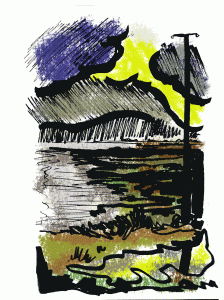
There are water-damaged signs informing us of the Dartford warblers nearby and the water rails skulking in the reeds. We don’t see them; perhaps more patience is needed. But we’re just glad to be here, happy to find another piece of that giant madman’s puzzle called London, a RSPB reserve accessible by Oyster card. It’s somewhere different, and we are here. Reeds and water pools beyond the reach of fashion and reappreciation, where the Thames is too wide and the traffic too close.
What do we see?
Lapwings in the hundred, snipe, tufted duck, teal, shelduck, shoveler, wigeon, linnets, a hovering kestrel, mute swan, Canada geese, greylag geese, redshank, long tailed tits, a little egret. The life that dwells on scrapes, in rushes, flitting from branch to pile of industrial rubble, on brown islands and bobbing on muddy water.
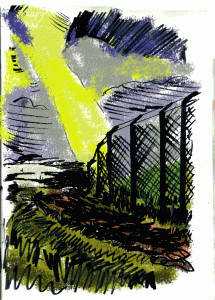 The Hamlyn guide lets us see what has changed and what has not. Thirty years is a long time.
The Hamlyn guide lets us see what has changed and what has not. Thirty years is a long time.
At one hide, twisted metal forms the word ‘marshland’, above a shining static bird (cormorant? heron? egret?) catching an iron fish mid-flight. This is a good place, we decide, and we’ll return in spring.
Near the end of the walk is the rarity identified by song; a Cetti’s warbler, darting from one patch of reed to the other. It helps make the day.
Cold air stings the eyes and the wind is picking up. Dark clouds gather strength in the skies above the reedbeds and icy drops start to fall.
Heaven is a marsh in winter.
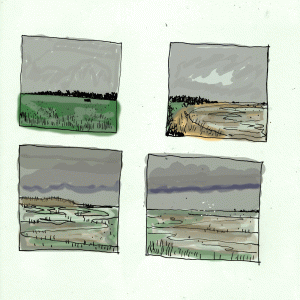
Gary Budden is the co-founder of independent publisher, Influx Press and works as an editorial assistant for Unsung Stories. His fiction and essays have appeared in Black Static, Structo, Bare Fiction, Gorse, The Lonely Crowd, Under the Radar, The Learned Pig and many more. Click here to read his blog: New Lexicons.
For more birdwatching from Gary, check out Specifics: Thoughts on birds and birdwatching
You might also like his article Common Ground: Rob Cowen on Edgeland Literature, Psychogeography & Nature Writing
Maxim Peter Griffin is a landscape artist, cartographer and walker based in Lincolnshire.
You can read Unofficial Britain’s profile of the artist here: Wobbly Lincolnshire Landscapes
Click here to read Walk to the Hill – Field Notes by Maxim Griffin
Click here to watch Super Grass: A Short & Wobbly Film by Maxim Peter Griffin









